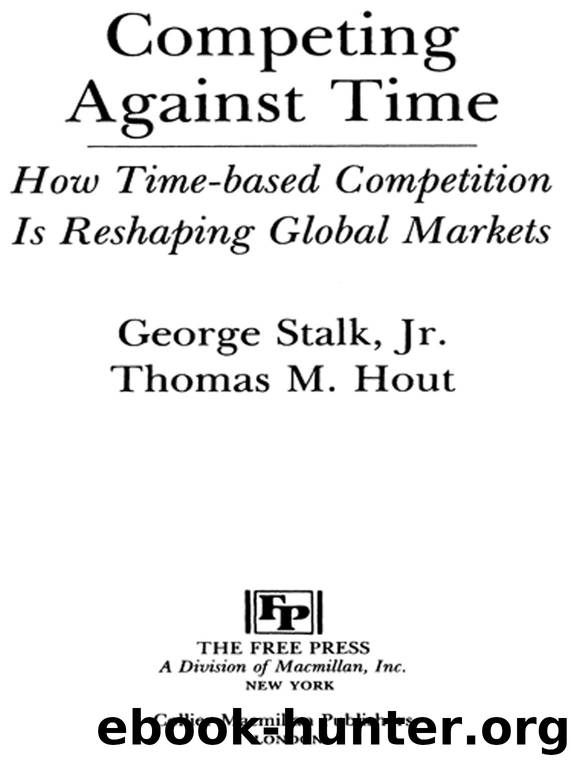Competing Against Time: How Time-Based Competition is Reshaping Global Mar by George Stalk

Author:George Stalk [Stalk, George]
Language: eng
Format: mobi
Publisher: Free Press
Published: 1990-02-28T14:00:00+00:00
TABLE 5-2 Summary of Performance Improvements (5-yr period)
Company Product Factory Labor Productivity Net Asset Productivity Product Line Variety
Yanmar Diesel engines 1.9⋉ 2.0⋉ 3.7⋉
Hitachi Refrigeration equipment 1.8 1.7 1.3
Komatsu Construction equipment 1.8 1.7 1.8
Toyo Kogyo Cars, trucks 2.4 1.5 1.6
Isuzu Cars, trucks 2.5 1.5 n.a.
Jidosha Kiki Brakes, etc. 1.9 n.a. n.a.
Simple average 2.0 1.8 2.1
Beginning in about 1978, a third Japanese manufacturer, Hitachi, began to install its version of Toyota’s production system throughout its factories in Japan, calling it the Hitachi MST (minimum-stock-minimum-standard time) system. They too, were able to boast substantial gains—80 percent in labor productivity and 70 percent in net asset productivity.* Another Japanese manufacturer, Komatsu, improved its labor and net asset productivity by these same percentages for construction equipment and diesel engines. Komatsu was second in size only to Caterpillar, and in the mid-1970s, Komatsu’s management also made an intensive effort to become more flexible with very successful results.
As successive Japanese companies followed Toyota’s lead, each seemed to improve on the one before. Toyo Kogyo, known today as Mazda, was driven to the brink of bankruptcy by the recession in the mid-1970s, as well as by its failed attempt to interest the market in a model with a rotary engine. In a bid for survival, the management of Toyo Kogyo made a crash effort to streamline the company and to cut costs drastically, by installing their version of the Toyota Production System. Labor productivity at the company increased by 140 percent, and net asset productivity increased by 50 percent.
The Japanese truck manufacturer Isuzu did even better than Mazda in terms of productivity increase, with labor productivity up 150 percent, and net asset productivity, up 50 percent. Second in size only to Hino Motors—a sister company of Toyota—Isuzu too had been forced into becoming more flexible. Although management at Isuzu are quick to admit that much more needs to be done, their results to date have been impressive.
Our final Japanese example here is a supplier of Toyota, Jidosha Kiki, which manufactures suspension components. In 1978, the company was achieving work-in-progress turns of about 78 times per year, but Toyota management thought its affiliate could improve performance. As in the case of Yanmar, Toyota assembled a team of engineers and sent them to Jidosha Kiki to improve the company’s flexibility. The results were impressive. Work-in-progress turns increased to 312 times a year, and management was committed to doing even better.
Download
This site does not store any files on its server. We only index and link to content provided by other sites. Please contact the content providers to delete copyright contents if any and email us, we'll remove relevant links or contents immediately.
The Meaning of the Library by unknow(2385)
Six Billion Shoppers by Porter Erisman(2225)
Why Nations Fail: The Origins of Power, Prosperity, and Poverty by Daron Acemoglu & James Robinson(2172)
No Time to Say Goodbye(1997)
Red Notice by Bill Browder(1924)
The Economist [T6, 22 Thg9 2017] by The Economist(1843)
Currency Trading For Dummies by Brian Dolan(1788)
Thank You for Being Late by Thomas L. Friedman(1679)
Bitcoin: The Ultimate Guide to the World of Bitcoin, Bitcoin Mining, Bitcoin Investing, Blockchain Technology, Cryptocurrency (2nd Edition) by Ikuya Takashima(1613)
Amazon FBA: Amazon FBA Blackbook: Everything You Need To Know to Start Your Amazon Business Empire (Amazon Empire, FBA Mastery) by John Fisher(1495)
Coffee: From Bean to Barista by Robert W. Thurston(1419)
The Future Is Asian by Parag Khanna(1401)
The Great Economists by Linda Yueh(1389)
Capitalism Without Capital: The Rise of the Intangible Economy by Jonathan Haskel(1339)
Pocket World in Figures 2018 by The Economist(1327)
How Money Got Free: Bitcoin and the Fight for the Future of Finance by Brian Patrick Eha(1322)
Grave New World by Stephen D. King(1315)
The Sex Business by Economist(1279)
Cultural Intelligence by David C. Thomas(1201)
